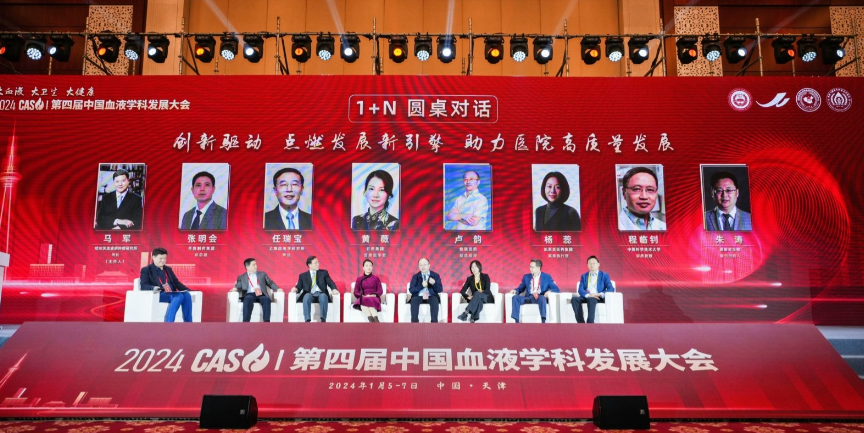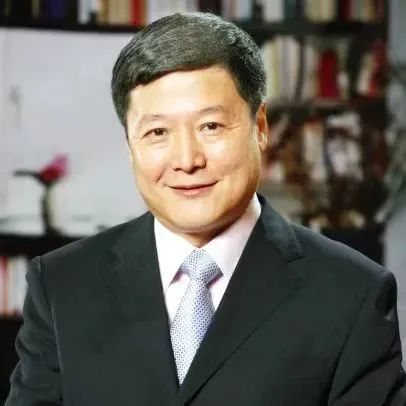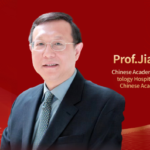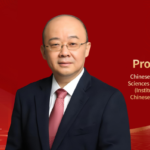Organized by the China Medical Science Academy Peking Union Medical College and co-hosted by the Hematology Hospital of the China Medical Science Academy (Institute of Hematology), the 4th Chinese Hematology Development Conference (CASH) was held with grandeur from January 5th to 7th in Tianjin. This year's conference continued to uphold the theme of "Big Hematology, Big Health," gathering more than 400 renowned domestic and international hematology experts, top scholars, and healthcare industry leaders. The focus was on the core development directions of hematology in China, exploring cutting-edge knowledge under the pulse of innovation and seeking innovative heights in the light of technology. On-site at the conference, "Oncology Frontier - Hematology Frontier" had the privilege of interviewing Professor Jun Ma, a leading figure in the field of hematology in China and the director of the Harbin Hematologic Tumor Research Institute. In this interview, Professor Ma compared ASH and CASH, analyzed the current status of hematology development in China and abroad, and pointed out the future directions for innovation in this field.
From ASH to CASH, the Commitment to “Everything for the Patient” Remains Unchanged
“Oncology Frontier – Hematology Frontier“: Professor Jun Ma, what do you think are the significant implications of domestic and international conferences like ASH and CASH for advancing the development of hematology?
Professor Jun Ma: In early December, our delegation attended the American Society of Hematology (ASH) Annual Meeting in the United States. A total of 163 attendees from China participated, including 103 clinical doctors and teachers from fields such as biopharmaceuticals, translational medicine, and basic medicine. At this conference, China had 468 research contributions selected, including oral presentations, poster presentations, and advisory board meetings. Moreover, over 30 individuals served as session chairs or co-chairs, generating considerable attention and interest in the international hematology community. On December 9th, we hosted “China Night,” attended by 120 participants, including the presidents of the American Society of Hematology, the Japanese Society of Hematology, and the European Hematology Association, along with Chinese experts and scholars. The President of ASH extended a warm welcome to our participation, saying, “Welcome back to the international community, and welcome Chinese scholars to this conference.” Among the 7,700+ research contributions accepted at the conference, Chinese scholars contributed 468. In areas such as cell therapy, lymphoma treatment, basic research, and especially CAR-T therapy, China is at a leading level, making significant contributions. For example, besides the international recognition of arsenic trioxide treatment for acute promyelocytic leukemia (APL), there is also the half-matched transplantation led by Academician Huang Xiaojun, as well as various CAR-T therapies, including BCMA CAR-T and CD19 CAR-T, which have received approval in China. Real-world research from China was also presented at the conference, receiving significant attention from the international hematology community. Approximately 35,000 people participated in the ASH Annual Meeting, both online and in-person.
On the other hand, the Chinese Hematology Development Conference (CASH) is a relatively new endeavor. Despite the establishment of the Institute of Hematology of the China Medical Science Academy, also known as the Tianjin Hematology Institute, in 1958, it has been 65 years, and hematology in China is still in a developing stage. Although we are approaching or even surpassing world standards in certain areas, there is still a considerable gap in many aspects, such as basic research, translational medicine, and various treatments, when compared to Western countries. Therefore, from ASH to CASH, spanning thousands of kilometers from San Diego in the US to Tianjin in China, I believe that for China to develop its own identity, unity, collaboration, and innovation are the six guiding principles for hematology in our country. Only when we unite, collaborate across various domains, including basic research, translational research, clinical practice, hematology, oncology, and multidisciplinary teams (MDT), along with fostering innovation, especially in the discovery of hematologic oncology drugs, can we achieve the present and future of hematologic oncology treatment. The common goal of both societies is to extend the survival and clinical cure rates for hematologic disease patients. Therefore, we need to continue our efforts.
The First Domestic CD19 CAR-T Therapy Opens a New Era in ALL Treatment
“Oncology Frontier – Hematology Frontier“: As the chair of the “CAR-T Frontiers Forum” and the “Immunocell Therapy” special forum at this conference, could you share the latest developments in China’s immunotherapy and cell therapy, especially in the field of Acute Lymphoblastic Leukemia (ALL)?
Professor Jun Ma: As you may know, we recently approved the first domestic CD19 CAR-T therapy for the treatment of adult relapsed or refractory B-cell acute lymphoblastic leukemia (r/r B-ALL). It has shown remarkable efficacy, with several patients achieving continuous complete remission (CR) for more than 18 months. Based on research led by Professor Wang Jianxiang, our regulatory authority rapidly granted conditional approval for this therapy, making it the world’s first CAR-T therapy for treating adult r/r B-ALL. This marks a new era for CAR-T therapy in ALL treatment in China. At the ASH conference, it was reported that using double/single antibodies and antibody-drug conjugates (ADC drugs) to achieve CR and MRD negativity before CAR-T therapy has become the ceiling. However, China faces significant challenges, with double/single antibodies and ADC drugs having only been approved for two to three years and CAR-T therapy for just a few months. Therefore, we need to accumulate real-world data. I believe that CAR-T therapy for r/r B-ALL has the potential to be curative, similar to allogeneic hematopoietic stem cell transplantation, while immunotherapy with double/single antibodies and ADC small molecule drugs may serve as consolidation and induction therapy. Regardless of the treatment approach, our overall goal is to extend the survival time of ALL patients and potentially achieve higher clinical cure rates. We still have a long way to go, including real-world research and phase III clinical trials, to bring China to the forefront of r/r B-ALL treatment, including immunocell therapy.
Looking Back to Inform the Future: The Promising Landscape of Chinese Innovative Drugs
“Oncology Frontier – Hematology Frontier“: In recent years, more and more domestically developed original drugs have been approved for marketing, even venturing abroad, bringing the “Chinese solution” to global hematologic tumor treatment. Could you please introduce the progress and future directions of China’s innovative anti-tumor drug research and development?
Professor Jun Ma: China has several typical drugs in the field of innovation, especially originating from China: Firstly, there is arsenic trioxide, which was discovered in the 1970s by Pharmacist Han Taiyun from the First Hospital of Harbin Medical University. It is used to treat acute promyelocytic leukemia (APL) and has gained international recognition. It is the first targeted therapy for APL, with a cure rate of up to 92%. Additionally, it achieves an 80% cure rate for relapsed/refractory patients. Therefore, it is known as the “Harbin Gold Standard M3 Protocol” and is considered one of the best treatment options globally. Secondly, there is all-trans-retinoic acid in its all-trans form, discovered by Academician Wang Zhenyi from Ruijin Hospital, Shanghai Jiao Tong University. When combined with arsenic trioxide, it induces treatment for M3, also known as “double induction,” raising the cure rate to 95%. Thirdly, in recent years, there is the semi-matched transplantation led by Academician Huang Xiaojun. Under his leadership, the Beijing University Institute of Hematology has introduced global innovations, creating a new era where “everyone can undergo allogeneic hematopoietic stem cell transplantation, and everyone has a donor.” In addition to outstanding innovations in hematology oncology, we also have many pioneering innovative drugs in fields such as liver cancer, lung cancer, and gastrointestinal tumors. However, compared to countries like the United States, Japan, and the United Kingdom, we still have a significant gap. As I mentioned earlier, China has entered the spring of innovative drugs, but the harvest season is still far away, possibly taking 10, 20, or even more years. Nevertheless, I believe that through the collaborative efforts of three generations of clinical experts, translational medical experts, basic medical experts, and pharmaceutical experts, we can bring Chinese innovative drugs to the international level and even achieve higher standards, which is our goal.
Grounded in Innovation: Three Aspects of True Innovation
“Oncology Frontier – Hematology Frontier“: Innovation drives development. During the roundtable discussion, you led multiple experts in exploring the impact of innovation on the high-quality development of hospitals. Could you please share more on this topic?
Professor Jun Ma: Innovation is not just a verbal commitment. One professor mentioned during the roundtable discussion that “innovation is highly scientific, not pseudo-science.” Therefore, we need to be honest, scientific, and rigorous in our pursuit of innovation. Currently, there are three areas where we fall short in innovation: First, inadequate research and development investment. The highest R&D investment by Chinese pharmaceutical companies is 29.8% of total revenue, while in Europe and the United States, it is typically over 30%. Many of our other biotech companies invest as little as 5% to 10%, making it challenging to secure sufficient funding for research and development. Second, we lack original innovation. Often, our innovation follows the “First-in-class” or “Me-better” approach. To achieve true original innovation, we need to put in significant effort, obtain our own patents, and have patents for the drug structure itself, including First-in-class patents. This is crucial. Third, we lack top-tier Principal Investigator (PI) teams. Anderson Cancer Center in the United States, for example, has 138 international top-tier PI research teams in one hospital, covering areas like breast cancer, lymphoma, lung cancer, and more. In China, there may be fewer than 38 PI research teams that can participate in international clinical trials. These three factors, insufficient funding, a lack of original innovation, and a shortage of top-tier PI teams, constrain the development of innovative drugs in China. Therefore, during the roundtable discussion, we brought together biopharmaceutical companies, including Contract Research Organizations (CROs), along with clinical professors to explore how we can foster innovation. We believe that only through unity and collaboration can we have the opportunity for innovation. This is also our future goal for innovation.

Professor Jun Ma
- Director, Chief Physician, Professor, Ph.D. Supervisor
- Director of the Harbin Hematologic Tumor Research Institute
- Chairman of the Board of Supervisors of the Chinese Society of Clinical Oncology (CSCO)
- Vice President of the Asian Society of Clinical Oncology
- Chairman of the Leukemia Expert Committee of the Chinese Society of Clinical Oncology
- Leader of the Expert Group on Oncology Discipline Construction and Continuing Education Center of the National Health Commission
- Editor-in-Chief of the Journal of Leukemia & Lymphoma


